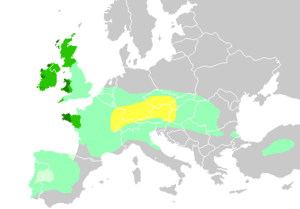Pre-Celtic

The term pre-Celtic refers to the period in the prehistory of Central and Western Europe postdating the emergence of the Proto-Celtic language and cultures and predating the expansion of the Celts or their culture in Iron Age Europe and Anatolia (9th to 6th centuries BC). The area involved is that of the maximum extent of the Celtic languages in about the mid 1st century BC. The extent to which Celtic language, culture and genetics coincided and interacted during this period remains very uncertain and controversial.
Languages
Proto-Celtic is mainly dated to approximately 800 BC, coincident with the Hallstatt culture, while the earliest divergence of pre-Celtic from Proto-Indo-European is mainly dated to between 3000 BC and 2000 BC.
In continental Europe, pre-Celtic languages of the European Bronze Age may be taken to comprise two distinct groups.
- Non-Indo-European languages (i.e. Pre-Indo-European languages); these include Basque,[1][2] Etruscan,[3] and perhaps Rhaetic. Some scholars group Etruscan, Rhaetic and Lemnian together in the hypothetical Tyrrhenian language family, which may have been originated from either Anatolia or the Minoan civilization.[4][5][6][7] Conversely, the Lemnian language could have arrived in the Aegean Sea during the Late Bronze Age, when Mycenaean rulers recruited groups of mercenaries from Sicily, Sardinia and various parts of the Italian peninsula.[8]
- Indo-European dialects, such as Illyrian, possibly Lusitanian, the Proto-Italo-Celtic dialects, Belgian and "Old European".[9]
It has been suggested that results of large-scale genetic surveys, undertaken since the late 20th century, cast serious doubt on the belief that the present-day speakers of pre-Indo-European languages represent relict populations. For instance, Basques show a dominance of the Y-DNA Haplogroup R1b,[10] which a majority of scholars now propose spread through Europe relatively recently, from southwest Asia in the Neolithic period or later (4,000 to 8,000 years ago).[10][11][12][13][14] However, present-day Basques also harbour some very rare and archaic lineages, such as the mitochondrial DNA Haplogroup U8a.[15] Moreover, it is a truism that the composition of any particular normative racial, linguistic group and/or material culture may represent an anthropological "Ship of Theseus": the links between members of such groups (e.g. DNA, language and artifacts) may vary to a significant degree over time.
Archaeology
In the later Celtic areas there were many disparate archaeological cultures.
History
When the Celts are first recorded about 600 BC they are already widespread across Iberia, Gaul, and Central Europe.
In Ireland the Book of Invasions gives a legendary account of the arrival of incoming peoples.
See also
- Neolithic Europe
- Old European culture
- Bronze Age Europe
- Old European hydronymy
- Pre-Germanic
- Vasconic languages
- Atlantic (Semitic) languages
- Pre-Roman peoples of the Iberian Peninsula
- Prehistoric Britain
- Bronze Age Britain
- Prehistoric Ireland
- Paleolithic Continuity Theory
- Italo-Celtic
- Goidelic substrate hypothesis
- Magdalenian
References
- ↑ Trask, R.L. 1997. The History of Basque. P.9. Citing Bertranpetit and Cavalli-Sforza: "Basques represent descendants of Paleolithic and/or Mesolithic populations and non-Basques later arrivals, beginning with the Neolithic.".
- ↑ Hualde, José Ignacio and Jon Ortiz de Urbina. A grammar of Basque. 2003. P.7
- ↑ Pallottino, 1955. The Etruscans:
...an ethnic island of very ancient peoples isolated by the flood of Indo-European speakers.
Page 52 - ↑ Facchetti, Giulio M. & Negri, Mario. Creta Minoica. Sulle tracce delle più antiche scritture d'Europa. Leo S. Olschki Editore, 'Biblioteca dell'Archivum Romanicum. Serie II: Linguistica' nº 55, 2003. ISBN 8822252918.
- ↑ Bonfante, Larissa (1990). Etruscan. Berkeley and Los Angeles: University of California Press. ISBN 0-520-07118-2.
- ↑ de Simone, Carlo (2009). "La nuova iscrizione tirsenica di Efestia". Tripodes. 11. pp. 3–58.
- ↑ Steinbauer, Dieter H. (1999). Neues Handbuch des Etruskischen. St. Katharinen: Scripta Mercaturae Verlag.
- ↑ De Ligt, Luuk. "AN 'ETEOCRETAN' INSCRIPTION FROM PRAISOS AND THE HOMELAND OF THE SEA PEOPLES" (PDF). http://www.talanta.nl. ALANTA XL-XLI (2008-2009), 151-172. External link in
|website=(help) - ↑ Kitson, P.R. (November 1996). "British and European River Names". Transactions of the Philologica Society. 94 (2): 73–118. doi:10.1111/j.1467-968X.1996.tb01178.x.
- 1 2 Balaresque, Patricia; Bowden, Georgina R.; Adams, Susan M.; Leung, Ho-Yee; King, Turi E.; et al. (2010). Penny, David, ed. "A Predominantly Neolithic Origin for European Paternal Lineages". PLOS Biology. Public Library of Science. 8 (1): e1000285. doi:10.1371/journal.pbio.1000285. PMC 2799514
 . PMID 20087410. Retrieved August 19, 2014.
. PMID 20087410. Retrieved August 19, 2014. - ↑ "International Society of Genetic Genealogy (ISOGG) - Y-DNA Haplogroup R and its Subclades". ISOGG. Retrieved 2010-08-22.
- ↑ B. Arredi, E.S. Poloni and C. Tyler-Smith, The Peopling of Europe, in M. Crawford (ed.) Anthropological Genetics: Theory, Methods and Applications (Cambridge University Press 2007)
- ↑ Myres, Natalie; Rootsi, Siiri; Lin, Alice A; Järve, Mari; King, Roy J; Kutuev, Ildus; Cabrera, Vicente M; Khusnutdinova, Elza K; et al. (2010). "A major Y-chromosome haplogroup R1b Holocene effect in Central and Western Europe". European Journal of Human Genetics. 19 (1): 95–101. doi:10.1038/ejhg.2010.146. PMC 3039512
 . PMID 20736979
. PMID 20736979 - ↑ Sjödin, Per; François, Olivier (2011). Lalueza-Fox, Carles, ed. "Wave-of-Advance Models of the Diffusion of the Y Chromosome Haplogroup R1b1b2 in Europe". PLoS ONE. 6 (6:e21592): e21592. doi:10.1371/journal.pone.0021592.
- ↑ González, AM; García, O; Larruga, JM; Cabrera, VM (2006). "The mitochondrial lineage U8a reveals a Paleolithic settlement in the Basque country". BMC Genomics. 7: 124. doi:10.1186/1471-2164-7-124. PMC 1523212
 . PMID 16719915.
. PMID 16719915.
Bibliography
- Thompson, T. Ireland's Pre-Celtic Archaeological and Anthropological Heritage. (2006) Edwin Mellen Press.
- Waddell, J., The Celticization of the West: an Irish Perspective, in C. Chevillot and A. Coffyn (eds), L' Age du Bronze Atlantique. Actes du 1er Colloque de Beynac, Beynac (1991), 349-366.
- Waddell, J.,The Question of the Celticization of Ireland, Emania No. 9 (1991), 5-16.
- Waddell, J., 'Celts, Celticisation and the Irish Bronze Age', in J. Waddell and E. Shee Twohig (eds.), Ireland in the Bronze Age. Proceedings of the Dublin Conference, April 1995, 158-169.
